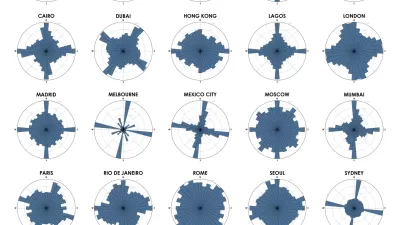Fresh from a lively debate about the desirability of the gridiron layout of cities at CNU 21, Paul Knight shares his eight central arguments for why one would be wise to use the rectilinear grid today.
At the recently held CNU 21 conference in Salt Lake City, Knight and Kevin Klinkenberg debated Howard Blackson and Bill Dennis on the value of the grid at an event Steve Mouzon called "the most entertaining session I think I've ever attended at a CNU." In this post, Knight summarizes the eight key benefits of the gridiron layout: walkable, navigable, adaptable, orthogonal, economical, sustainable, appendable, historical.
To get a glimpse at the counter-arguments, see Mouzon's post about the Great American Grid Debate.
"Do not succumb to the knee-jerk reaction that grids are boring," concludes Knight. "Instead, take a deep breath, go to Google Earth, and drop the Google-Street-View-Man onto a grid. You will find a variety of places (good, bad, and great) all predicated upon the exact same city plan. The grid can be as wonderful or as terrible as you decide to make it. All I am saying is give grids a chance."
FULL STORY: Benefits of the grid

Maui's Vacation Rental Debate Turns Ugly
Verbal attacks, misinformation campaigns and fistfights plague a high-stakes debate to convert thousands of vacation rentals into long-term housing.

Planetizen Federal Action Tracker
A weekly monitor of how Trump’s orders and actions are impacting planners and planning in America.

In Urban Planning, AI Prompting Could be the New Design Thinking
Creativity has long been key to great urban design. What if we see AI as our new creative partner?

King County Supportive Housing Program Offers Hope for Unhoused Residents
The county is taking a ‘Housing First’ approach that prioritizes getting people into housing, then offering wraparound supportive services.

Researchers Use AI to Get Clearer Picture of US Housing
Analysts are using artificial intelligence to supercharge their research by allowing them to comb through data faster. Though these AI tools can be error prone, they save time and housing researchers are optimistic about the future.

Making Shared Micromobility More Inclusive
Cities and shared mobility system operators can do more to include people with disabilities in planning and operations, per a new report.
Urban Design for Planners 1: Software Tools
This six-course series explores essential urban design concepts using open source software and equips planners with the tools they need to participate fully in the urban design process.
Planning for Universal Design
Learn the tools for implementing Universal Design in planning regulations.
planning NEXT
Appalachian Highlands Housing Partners
Mpact (founded as Rail~Volution)
City of Camden Redevelopment Agency
City of Astoria
City of Portland
City of Laramie





























